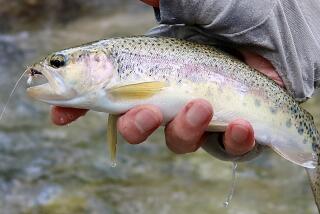Action on Tollway Drainage Is Absent
To the dismay of community leaders, neither Caltrans nor state water regulators plan any immediate fixes to faulty filter drains along the San Joaquin Hills toll road that are suspected of sending tainted runoff into the local watershed.
There are 39 filters along the toll road designed to block pollutants in rain runoff from flowing into canyons and eventually to beaches. But Caltrans has acknowledged in documents that 35 of those filters are not working properly, and that it is too expensive to maintain them.
State water regulators said last week that they are concerned about the problem but do not plan to do anything about it immediately because there is no proof of environmental harm and they are overwhelmed by more pressing issues.
“The discharges from that roadway, to my knowledge, are not closing beaches or killing migratory birds,” said John Robertus, executive director of the San Diego Regional Water Quality Control Board, a state agency that has jurisdiction over the area. “That doesn’t mean there isn’t something slow and deadly going on out there.”
But because of this uncertainty, Robertus said his agency has put a low priority on addressing filter problems for now.
Others, however, are frustrated that more immediate action is not being taken to study the degree to which faulty filters are allowing polluting of the watershed and to formulate a solution.
In Laguna Beach, for example, city officials long have worried that runoff from the road is reaching local shores.
“I see Caltrans officials throwing their arms up and saying the filters don’t work and we’ll just study it for a couple of years,” said Laguna Beach Councilman Wayne L. Baglin, who also serves on the regional water board. “We were given assurances that there would be no pollution coming off that toll road and into the creeks and the ocean.”
The mayor and other City Council members have also expressed frustration.
At the very least, Baglin said, Caltrans should sample the runoff and determine its effect. After that, the water board could decide whether to issue an order forcing Caltrans to do something, he said.
He said Caltrans also should come up with a temporary measure to reduce the amount of runoff washing from the tollway into creeks and other downstream waters.
“It’s my opinion that they’re obligated to do that,” he said. “It’s not voluntary on their part.”
As a last resort, he added, the city could file a civil lawsuit demanding action by Caltrans. A few years ago, he said, the city of Santa Monica filed suit in a similar case that was settled when Caltrans agreed to significant cleanup efforts.
Community leaders and water regulators said they were unaware of the extent of the drainage problem until The Times, citing documents obtained from Caltrans, reported last week that nearly all of the filters along the highway don’t work and should never have been installed.
An internal study by Caltrans concluded that the technology used is obsolete and that fixing the filter problem is at least two years away. In the meantime, the agency found, it would be simply too expensive to properly maintain them.
Designed by Stormwater Management Inc. of Portland, Ore., but constructed and installed by other subcontractors, the filters are supposed to block pollutants from flowing into canyons and down to the ocean.
Stormwater Vice President James Lenhart said, “If the systems are maintained according to the original recommendations, they will function as designed.”
Bob Morris, a senior engineer who supervises the northern watershed for the regional water board, said his staff is reviewing environmental permits for the toll road to better determine whether Caltrans is meeting its responsibilities.
“We’re still conducting some research on these filters up there,” he said. “We’d like to go back [over the contract and other documents] to see what the purpose of those filters were.”
Water regulators, meanwhile, said that although they don’t plan any immediate action, the problem might make them more skeptical when reviewing new plans to extend the toll-road system in Southern California.
“When they were getting ready to build the San Joaquin [tollway], it was supposed to be the end-all of all environmental highways,” Robertus said. “They made all the promises that the road would be the best thing since sliced bread.”
(BEGIN TEXT OF INFOBOX / INFOGRAPHIC)
In Limbo
Caltrans has no immediate plans to fix the drainage system designed to filter storm water runoff from the San Joaquin Hills toll road. How the system is intended to work.
More to Read
Sign up for Essential California
The most important California stories and recommendations in your inbox every morning.
You may occasionally receive promotional content from the Los Angeles Times.










